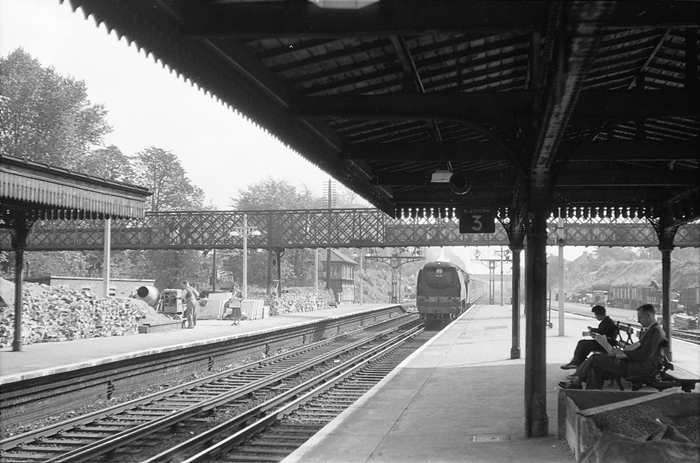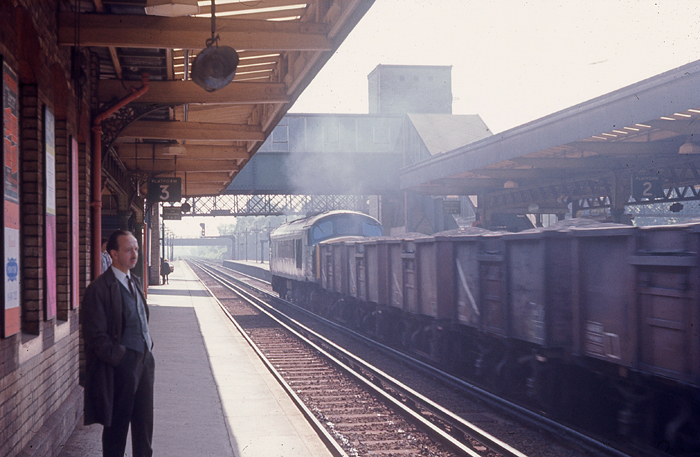

Bromley South
Today, this is a
busy commuter station on an intensively-used main line between London and the
Kent Coast, serving a population of about 310,000 in a south eastern suburb of
London. Once, however, it was a typical rural affair in North West Kent,
providing rail access to the market town’s population of 20,000 (1861).
The station at Bromley opened on 5th July 1858 on a double-track line which, at
that time, went as far as Battersea in the west, on the southern bank of the
Thames, and stretched to Bickley in the east. The upcoming opening of the line
through the town had been reported in The Bromley Record on 1st July
1858:
The long expected time has at length arrived, and Bromley this day, Monday,
July 5th, will find itself accommodated with no less than twenty trains to
London, eleven of which will be supplied by the Mid-Kent to London Bridge, and
nine by the West London and Crystal Palace to Pimlico. The companies are
reported to be of different opinions respecting the amount of traffic which each
of them is entitled to. The consequence is, that the West London and Crystal
Palace companies refuse to accept the offer of the South Eastern company to work
the line between Beckenham and Shortlands, which is only a single line at
present.
The route had been commissioned in
the following stages:
West End of London & Crystal Palace
Railway
- Crystal Palace to Wandsworth Common: 1st December 1856
- Crystal Palace to Norwood: 1st October 1857
- Wandsworth Common to Pimlico Terminus (Battersea): 29th March
1858
- Norwood to Bromley (today called ‘’Shortlands’’): 3rd May 1858
Mid-Kent (Bromley to St Mary's Cray)
- Bromley (Shortlands) to Southborough Road (Bickley): 5th
July 1858
The
Mid-Kent (Bromley to St Mary's Cray) had received
Royal Assent on 21st July 1856 and the company was authorised to raise
£70,000 capital in £10 shares, in addition to a further £23,000 in loans for
this undertaking (Bradshaw's Shareholders' Guide 1862). The line's
total length between Bromley (Shortlands) and St Mary Cray was 4
miles 7 furlongs. Although this later became a key part of the East Kent Railway's trunk
route, an arrangement between the Mid-Kent and SER companies initially
resulted in the latter agreeing to work the line. A formal lease of the
route by the SER had yet to receive Parliamentary approval, so in the
meantime, this company was to operate the line on similar terms until a lease
deal was properly sanctioned.
The Bromley Record and Monthly Advertiser
VOL 1 (June 1858 to December 1860)
Mid-Kent (Bromley to St Mary's Cray) Company
At the fifth half-yearly general meeting of the above company, August
16th, 1858, the Directors presented their report, from which we cite the
following:
''The Directors have the pleasure of stating that during the six weeks that
the railway has been open, the gross receipts at the Bromley and
Southborough-Road Stations have amounted to £571 8s. 9d, which show an
average £95 5s. per week for passenger traffic alone.
''Accommodation for passengers, goods, and coal is now being provided at
Bromley, upon an enlarged scale, at the request of the South-Eastern
Company. The cost of those works, therefore, will exceed what had been
previously considered sufficient by the Board; but looking to the important
and obvious advantages which the Bromley Station will afford to a large and
increasing traffic, the Directors felt themselves justified in adopting the
requirements of the South-Eastern Company.
''The Directors have to report, that the Bill referred to in the last
half-year's report, for powers to lease the undertaking to the South-Eastern
Company, has been rejected by Parliament. They deem it necessary also to
acquaint you, that Parliament has sanctioned the Bill promoted by the East
Kent Company, for enabling them to extend their railway from Strood to join
the Bromley and St Mary Cray Railway; rejecting the line promoted by the
South-Eastern Company.''
The first Bromley station comprised two platforms
set around a double-track. A two-storey-high station building, with a hipped
slated roof, existed on the ‘’up’’ platform; this had a not too dissimilar
appearance to the main structure which later opened with the LC&DR’s
Wandsworth Road
station in 1863. The ‘’down’’ side was host to a small waiting shelter and
passengers crossed the tracks on the level between
platforms (a covered footbridge was provided about twenty years later).
A goods yard existed on the ‘’up’’ side of the line and this comprised coal
staithes at its eastern extremity and a tidy goods shed at the western end. The
latter sat behind the ‘’up’’ platform and was of familiar brick construction
with a slated pitched roof, and accommodated a single through track. Passing
over the middle of the yard and across the running lines was a timber footbridge,
which formed part of a public footpath.
Bromley South: 1935

Click the above for a larger version. Drawn by
David Glasspool
1957

An
eastward view shows Unrebuilt Battle of Britain Class No. 34087 ''145
Squadron'' approaching with a Dover to Victoria boat train. There is plenty
of bygone detail in this view, including the original LC&DR canopies, the
Saxby & Farmer signal box, the goods yard (on the right), and the lattice
public footbridge. © David Glasspool Collection
Next: The History Continues >>
Return to the
Kent Rail Homepage or alternatively, check for
Updates.
Website & Copyright information -
Links -
Contact the Webmaster
All content is
copyright ©
David Glasspool
unless otherwise stated


